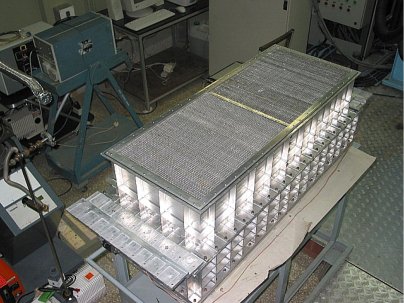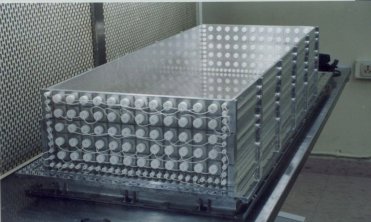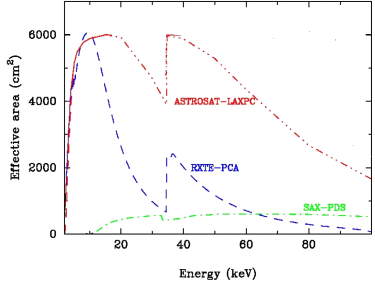The LAXPC Instrument:
For X-ray timing and low-resolution spectral studies over a broad
energy band (3-80 keV) ASTROSAT will use a cluster of 3 co-aligned
identical Large Area X-ray Proportional Counters (LAXPCs), each
with a multi-wire-multi-layer configuration and a Field of View
of 1ox1o. These detectors are designed to
achieve (I) wide energy band of 3-80 keV, (II) high detection
efficiency over the entire energy band, (III) narrow field of
view to minimize source confusion, (IV) moderate energy resolution,
(V) small internal background and (VI) long life time in space.
Xenon based gas mixture at a pressure of two
atmospheres will be filled in multilayer 15-cm deep detectors
to achieve an average detection
efficiency of close to 100% below 15 keV and about 50 % up to
80 keV. A thin (thickness 25/50 micron) aluminized Mylar
window for X-ray entrance will ensure a low energy threshold of
about 2-3 keV. The Mylar film will be supported by a honeycomb
shaped window support collimator with a 5ox5o
field of view. A field of view of 1ox1o will
be provided by using mechanical collimators made of a sandwich of
tin,copper and aluminium coaligned with the window support collimator
and sitting above it.

A LAXPC unit for test in a balloon flight experiment.
This is similar to the unit to be flown on ASTROSAT except that
it has a 3o x 3o field of view collimator.
The LAXPC detector housings are milled out of single blocks of
high tensile strength Aluminium alloy to ensure light weight
and structural integrity required to withstand large pressure
difference in the large volume detectors. Each detector will be
shielded with a tin and copper sheet to prevent leakage of X-rays
into the detection volume from the detector walls.
Mutual and veto layer anticoincidence logic will be employed
between the large number of anode wires to ensure rejection of
unwanted charged particle background signals and Compton scattered
high energy photons. The X-ray detection volume of each detector
will consist of 60 anode cells, each with a cross section of
3cm x 3cm, arranged in 5 anode layers.

The LAXPC X-ray detection anode assembly with veto layer on 3
sides mounted on the back plate
The total effective area of the 3 LAXPCs will be
about 6000 cm2 at 5keV. Due to its large depth and
high gas pressure the LAXPC will have high detection efficiency
right up to about 80keV, as shown in the figure below.

Effective area of ASTROSAT LAXPC compared with RXTE PCA and
BeppoSAX PDS. The effect of transmision through the Mylar
window is included.
To achieve good energy resolution of the detectors, it is necessary
to have a uniform gain over the entire area and the gas needs to be
free from impurities like oxygen and water vapour. The former will
be achieved by precision placement of the anode wires at the center
of the cells and by use of anode wire of uniform diameter. An onboard
purifier that will be used to purify the gas from time to time will
prevent degradation of energy resolution due to slow outgassing from
detector walls. Oxisorb purifiers with onboard compressor for gas
flow will be used for this purpose.
The high sensitivity of the LAXPC instrument will allow the detection
of a 0.1 mCrab source at 5-sigma level in an exposure of about
104 sec. This will enable the LAXPC to address a wide
variety of science -
click here for a
brief description.



















